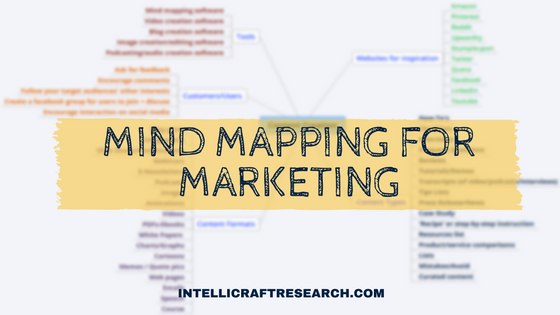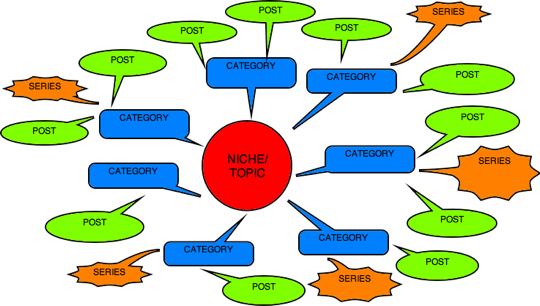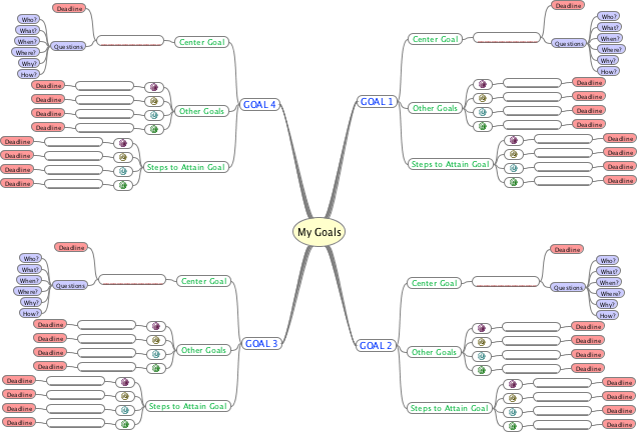Mind-Mapping for Library Marketing Planning

Have You Used Mind-Mapping in Your Library Marketing Planning? Try it!
Many of us are visually-oriented and can benefit from organizing information in a visual manner. That’s one reason the sticky note marketing planning technique I’ve shown you can be so easy to grasp and put in practice. But what if you want to try a different method for organizing your thoughts and activities in your marketing and content planning? Time to give mind-mapping a try!
What’s a Mind Map Anyway?
It’s a way of sorting and organizing information and the connection between pieces of information, visually. Mind maps aren’t linear, which is great for those of us who aren’t always linear thinkers! You can map out a strategic plan, your marketing goals, your content plans for the quarter, or individual blog posts or videos. You can probably use a mind map for just about any part of your work!
How Can a Map Help Marketing Planning?
Brainstorming via a mind map encourages free association and a judgment-free zone. All ideas are valid, put them on the map and decide later if they fit or are good for your project. If you come up with a lot of ideas unrelated to your original creative session or theme, start a new, separate mind map and work on it later. Or if your map starts getting complicated and unruly, cut one or more sections of the map out and save them as new maps.
The process of mapping helps us think creatively and pushes out to get of our ‘normal’ routines. There are no wrong answers and it’s easy to make changes as you see new patterns or relationships. Maps create order out of chaotic thoughts, or take an overwhelming topic (marketing plan for the year) and break it down (quarterly themes, monthly themes, related blog posts and videos, etc).
You can generate ideas for blog posts, a podcast episode, a video series, a more engaging FAQ and so much more. You’ll probably generate ideas faster during a mapping session than if you just tried to type or write a list. You’ll more easily see which topics and pieces of marketing content are truly related and which seem forced. Maybe you see that something needs to turn into 2, 3, or 4 posts or videos instead of a 1 mega piece of content.
Mapping makes it easier to see the gaps in your planning. You see what pieces of content are missing, what common user questions are still unanswered, or where you need better transitions around a key library theme or topic. It’s logic mixing with visuals and triggering a kind of ‘magic’ gap detection. Well, it feels like magic sometimes!
How to Get Started Mind-Mapping Your Marketing
- Start from the Center – traditionally, mind maps start with exploring a central theme, topic, idea or question and then branch out from there. So that starting question or topic is put in the center and the new ideas move out from there.
- Put 1 topic, keyword, idea or question in the center of your map (on paper, a whiteboard, in PowerPoint, or via an app or mind-mapping software – see below resources list).
- Write other ideas and thoughts as spokes radiating from the center; or as sub-circles off your main; or just write the words in a big circle or spiral around the center.
- Then stop and think of what new ideas or questions come from each of those sub-topics. Ask ‘so what?’ or ‘why does my audience of users care about X?’ – and as you come up with answers, branch those out.

- Emphasis on Relationships – what keeps it from being a random list of every marketing thought, tactic or event you have swirling in your mind = connection. How are these sub-topics and sub-sub-topics related to the center and to each other? Mark which connections seem to be tight and strong, which are tenuous or weak, or which you should explore further. It doesn’t have to be exact; there’s no right answer, just what comes to you as you do this, based on what you know about your library and its goals.
- Keep It Simple – single words or concepts are better than complex or bundled items. Use as little text as possible. Do use colors, symbols, pictures, doodles (most of the software tools will let you add images, graphs, other files, color coding). Just don’t go overboard with your color-coding. It still needs to make sense at a glance. If you don’t know where to put an idea, let it ‘float’ until you see its connections.
- Ask Questions – keep asking ‘so what?!’ and use the classic 5-Ws (Who, What, Where, When, Why, and How) to stimulate your brainstorming and also keep you focused on your goals and needs of your library’s audience of users.
- Maybe you want to map out a Pros vs Cons for a tool, app, product or service.
- Use the 5-Ws questions to map out a how-to blog post or video.
- Think about: Who this piece of marketing is for; Where will it be going; When is it being promoted or displayed and for how long; What is the core message it must convey; Why is that message important for a given part of your audience; and How will it get done.
- g. a video – Who is it for? Where will you film it? What are you teaching in this video? Why is that important for your audience? When will it be filmed? How will it be promoted?

This maps shows I might expand a recent post I shared [Click to open map + click again to expand to larger size]
- Mind Maps are Fluid – you can easily change them, add to them, edit them, or break them up into multiple maps. Don’t stop, don’t think, just do it. Just let the map flow. Keep adding ideas, spiking and branching out from the center. If you get hung up or stumped on 1 word or idea, leave it and move to somewhere else on the map. If a branch starts to get long or veers off target too much from your center – no problem, snip it and turn that branch into a new map.
- Collaboration – mind-mapping can be part of team or group exercises in planning (physically or virtually, in real time or with members dropping to contribute as they can). It’s an easy way to let all members of a marketing team or department add an idea, expand on relationship or comment on a gap they see that others may have missed.
- Repurposing – mind-mapping is an excellent tool for extending your ideas and existing marketing work. You should always be thinking of ways to take something you created in one format and repurpose it into a different content – so it reaches different parts of your audience, so those who learn and interact with content can find your message in their preferred format, and so you don’t wear yourself out reinventing each time!
- g. Take your most recent short form of content (a blog post, short video, an article) and put its title/topic at the center of a map. Now set a timer for 5 minutes (seriously, just 5 min!) and jot down/map out every way you could possibly take this idea and expand it further.
- What questions did you not have time to answer in a video? Which questions came in later via the comments or social media? What’s the opposing view of what was in that post? Or is there an alternative to the tool, database, or book you reviewed? Do you have commentary or a point of view on the topic that has changed since you created the post or video? Do you have more details you could add to a how-to, a resource round-up, or a case study/testimonial you shared? Is there a visual way to describe and show what you wrote in text?
- Great! Set the timer for another 5 minutes, pick one of those ways you expanded your original topic and map out all the formats and places you could share a new piece of content on that expanded idea.
- If the original was a blog post, you can create a new blog post; but what about a slide show instead? Or an infographic, or a short video with just text and pictures? Maybe you record an audio interview or podcast episode? Or a video interview with someone in your community and another librarian? Or …. keep going, keep brainstorming and mapping!

I created this map to show how to take 1 piece of content and create related pieces [click to expand map to larger size]
Tools/Resources for Mind-Mapping
- Whiteboard and dry erase markers – or go even more ‘old-school’ with blank paper and colored pens or pencils. Elements can be added and erased easily.
- Post-Its and a large table or blank wall – because they can easily be moved or rearranged as new ideas and relationships form. Get several colors of Post-Its.
- PowerPoint or Keynote – you can draw boxes, circles and add arrows to connect them in your own version of a map
- Freemind – is an app built in Java that is thought to be very user-friendly http://freemind.sourceforge.net/wiki/index.php/Main_Page
- XMind – Free to download, very popular and used by millions (I used this one to create several of the maps shown above – and it opens nearly all other mind maps from other software) http://www.xmind.net/
- Mind Meister http://www.mindmeister.com/
- Mind Maple http://www.mindmaple.com/Downloads/Windows/
- Bubbl.us https://bubbl.us/
- MindNode – another user-friendly, basic map maker; designated an Apple ‘App Store Best’ [Available for Mac, iPhone, iPad]
There are many other free and paid mind mapping apps or software offerings to download. The ones above are the most popular. Do some searching, check out the interfaces, look at other options and try a few to see which ones are intuitive for you to use. No one says you MUST use software to mind map. If you can’t or won’t use it, it’s not a very useful tool!
Mind mapping added to your marketing tool kit can give a serious boost to your content development, your info organization and keep you from getting stuck in your planning.
I’m not a naturally abstract thinker. I’m pretty linear though I have more fluid and dynamic moments. I AM a visual thinker. So, that’s why I appreciate being able to literally see existing connections or make new ones. I know I’ve been pleasantly surprised at how quickly I can adapt and do brainstorming with the visual representation of the mind map.
Show Me Your Mind Maps!
Let me know if you’ve tried mind mapping in any form. Have you used it for your marketing planning? Are you considering it now? What’s your favorite mind mapping software? What system or process has worked well for you in the past? Send me an email, or share via social media.

